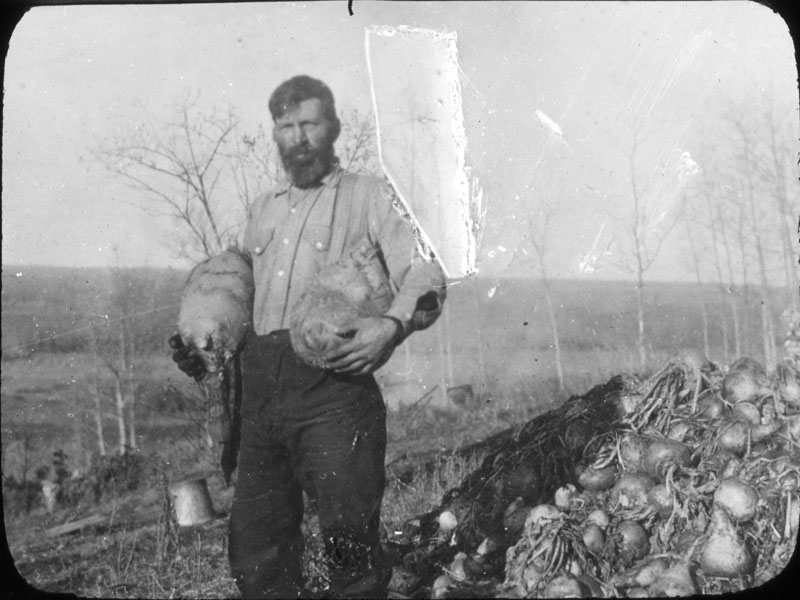Above: O. H. “Rutabaga” Johnson and his rutabagas, ca. 1920 (SPRA 362.02.12.13)
Oliver Hiram Johnson was born on August 16, 1856 in Capron County, Illinois to Norwegian parents. Anna Marie (Mary) Brotan was born on July 14, 1859 in Norway. Oliver and Mary were married in Wisconsin in 1880, then moved to South Dakota where they farmed until 1897. The Johnsons next had a mercantile in Gordon, Nebraska, then moved to Lawton, Oklahoma at the time of the Oklahoma land rush in 1901. The Johnsons had nine children.
In the summer of 1907, Oliver came to Canada, seeking a new home. He traveled with two other men from Edmonton, destined for Athabasca Landing, but when his partners decided to turn back at Sawridge, he joined up with Rede Stone’s group instead. When spring came, they continued on to Beaverlodge over the Long Trail (Athabasca Trail). Oliver settled on the river at the mouth of Hay Creek (NE 10-72-10 W6th). He spent the summer and fall breaking land, planting a garden, hunting, and building a house, barn, and other structures.
That summer, Oliver raised two acres of rutabaga. His son John notes that “as it was a wet summer they grew well and survived the frequent frosts… He harvested only a small percentage of them. He told Chief La Glace and his friends to help themselves. Whether his generosity ruined any possible market for them or not he acquired the name ‘Rutabaga.’”
In December of 1908, Oliver departed for Edmonton again to join his family. When he arrived in early February of 1909, they all returned to Beaverlodge together, bringing their belongings, provisions, and stock for a small store. They departed from Edmonton on March 3, 1909, traveled over the Long Trail, and arrived in Beaverlodge on April 9, 1909. The Johnsons moved to a new house in May and opened their store in June, the only trading post west of Lake Saskatoon. They obtained the patent to their homestead in 1914.
Oliver suffered from a hernia for many years. In 1916 he was transported to Edmonton and died in October at the Royal Alexandra Hospital, following surgery. Mary Johnson died in July 1942. The Johnson farm, known as “Stony Point” was sold in 1965. Part of it is now home to the South Peace Centennial Museum.
If you would like to view Rutabaga Johnson’s diary, a digital copy and a transcription are available on our website.
This article was originally featured in the December 2020 issue of Telling Our Stories.
